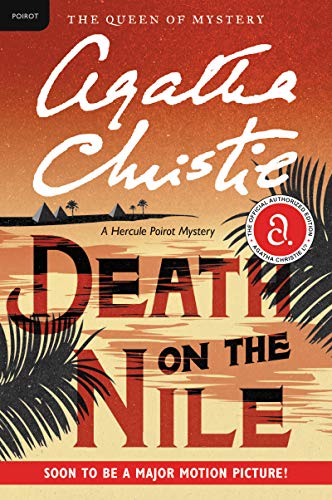In Wisconsin, summer is a time for nature immersion. Whether you hike in the woods, take to the lake in a boat, or hunt for bugs’n’birds’n’fairies, this is the season for journeys into the wilderness of the North Woods.
Every venture “Up Nort'” requires mysteries for road reading. Since Bo had gotten me some Poirots for Mother’s Day, this seemed like the perfect time to catch up on them. (Bo can’t read in the car because a)motion sickness and b)my driving style freaks him out.) What was meant to be a little simple escapism turned into a reflection on narrative point of view and how it helps–or hurts–a story’s ability to hold a reader.

Back when I was researching the nonfiction writing workshop I had to give at my university last month, I came across an article that referenced “Fleming Method.” This method, the author said, called for blasting through a story by writing only key elements: the dialogue, the action, etc. All the other elements were to wait for the next draft. Doing this allowed Ian Fleming to complete the initial draft of Casino Royale in a few weeks.
After reading Sad Cypress–published years before Casino Royale–part of me now wonders if Christie came up with the Fleming Method before Fleming did.
The premise is clear-cut.

Beautiful young Elinor Carlisle stood serenely in the dock, accused of the murder of Mary Gerrard, her rival in love. The evidence was damning: only Elinor had the motive, the opportunity, and the means to administer the fatal poison.
Yet, inside the hostile courtroom, only one man still presumed Elinor was innocent until proven guilty. Hercule Poirot was all that stood between Elinor and the gallows.…
The story itself is divided into three parts: Elinor’s flashback through all the events preceding the murder, Poirot’s investigation of the murder, and then the trial. Again, clear-cut.
Yet when I finished the book, I let out a “hmph” and tossed it onto the car’s dashboard.
Bo’s not used to me doing that, especially after what was, by all accounts, a good morning. We had successfully completed a walk and lunch at a beer garden with the kids–a HUGE accomplishment when two out of three are picky eaters. “Wasn’t the book okay?”
The mystery itself, I explained was fine. There’s a love triangle of sorts, a girl gets murdered, Poirot eventually shows up to investigate, yadda yadda. But the way Christie tells it was weird.
Bo gave me a look. “What do you mean?”
I show him a thick pinches of text–Part 1, the flashback. It’s all quite narrative, with descriptions, exchanges, changes of scene. Part 2 changes point of view character-wise, from the accused murderess to Poirot. Again, we’ve got multiple elements of storytelling. Grand. Part 3, however, drops almost all pretense of story-telling and moves forward almost entirely through dialogue–that is, through the exchanges between witnesses and lawyers during the trial. After 200 pages of “traditional” storytelling, 50 pages of almost pure dialogue jolted me so much I found myself nothing but irritated with the story when the mystery was resolved.
Bo considered. “Has Christie done that before?”
I don’t think so, I said. The cynical teacher in me imagined Christie was on a time crunch, didn’t much care for the story, and decided to just slap together the ending so she could move onto something she did want to write. Or maybe she was so mentally drained from writing And Then There Were None the year before that she needed to put out SOMEthing to appease the publishers. But I don’t know for sure, I said with a shrug, and the reception on this road sucks too much for me to do any deep digging.
“So how does Christie normally write a mystery?”
I stared at Bo so long that Biff scolded me. “It’s rude to stare, you know!”
How did Christie “normally” write a mystery? Was there such a thing as “normal”?
I looked at the other books I had packed along: Dumb Witness, After the Funeral, and Death on the Nile. I thumbed through them, sharing observations with Bo as I went…

Dumb Witness

Everyone blamed Emily Arundell’s accident on a rubber ball left on the stairs by her frisky terrier. But the more she thought about her fall, the more convinced she became that one of her relatives was trying to kill her.…
On April 17th she wrote her suspicions in a letter to Hercule Poirot. Mysteriously, he didn’t receive the letter until June 28th…by which time Emily was already dead.…
This story had a mix of methods I both liked and disliked. The first few chapters involve a lot of head-hopping amongst the characters of the victim-to-be’s family. I have written about this head-hopping before–nope, not a fan of this “I’m thinking murderous thoughts” to “and I’m thinking murderous thoughts, too!” to “oh, we’re just aaaaaaall thinking murderous thoughts, aren’t we?”. After those opening chapters, however, the unreliable-yet-charming Captain Hastings takes over as narrator until the end of the book. I’ve also written about benefits of the unreliable narrator for mystery writing, and in Dumb Witness those benefits were seen once again: clues quickly dismissed by the narrator Hastings carry crucial importance, and characters Hastings suspects or respects often tend to be something else entirely.
I always enjoy a trip alongside Poirot and Hastings; the two have a wonderful chemistry that allows for light-hearted moments, such as when the victim’s intelligent dog takes such a liking to Hastings that Hastings feels he knows what the dog is saying.
If Christie had written every Poirot mystery with Hastings, though, the misdirections would grow tedious, the joviality stale.
In other words, we’d get bored.
After the Funeral (also known as Funerals are Fatal)

“He was murdered, wasn’t he?”
When Cora Lansquenet is savagely murdered, the extraordinary remark she had made the previous day at her brother Richard’s funeral suddenly takes on a chilling significance. At the reading of Richard’s will, Cora was clearly heard to say, “It’s been hushed up very nicely, hasn’t it. But he was murdered, wasn’t he?”
Did Cora’s accusation a dark truth that sealed her own fate? Or are the siblings’ deaths just tragic coincidences?
Desperate to know the truth, the Lansquenet’s solicitor turns to Hercule Poirot to unravel the mystery. For even after the funeral, death isn’t finished yet . . .
I hope you like head-hopping, because this story moves from character to character in an entire family tree throughout the whoooole novel. For the record, I didn’t throw this book out the car window because a) I recalled some of the plot from the David Suchet adaptation, but not all the bits and that was really irritating, and b) the kids would have yelled at me for littering, which would have been even more irritating.
But, I must admit, there was something else here, a good something that kept me wanting to remember the solution. For all the head-hopping, there remained a consistent uncertainty between characters, a singular dread of not feeling entirely comfortable around one’s own family, of relief for getting money and the simultaneous guilt for being thankful someone died so that money could be given. By giving these characters that mutual guilt and suspicion, the narrative no longer jostles readers about. We’re still following that dread, catching the little things that make the characters unique instead of having those things hit us in the face page after page after page to remind us who’s who.
Death on the Nile

The tranquility of a cruise along the Nile was shattered by the discovery that Linnet Ridgeway had been shot through the head. She was young, stylish, and beautiful. A girl who had everything . . . until she lost her life.
Hercule Poirot recalled an earlier outburst by a fellow passenger: “I’d like to put my dear little pistol against her head and just press the trigger.” Yet in this exotic setting nothing is ever quite what it seems.
I feel like this is the mystery that inspired spoofs like Monty Python’s Agatha Christie sketch or the movie Clue–you know, where someone says, “I saw the ___ who did it!” And just before that someone says a name, the lights go dark, a shot rings out, someone groans, and thud–another murder.
(I’m likely quite wrong on this, but that sort of scene is in Death on the Nile, so it’s all I can think about now.)
Blessedly, Death on the Nile is told with an omniscient narrator who mostly follows Poirot about, only occasionally lingering with other characters if there’s a romance arc to propel along.

The narrator never focuses readers away from what Poirot’s doing, nor does the narrator give unnecessary attention for the sake of distraction or red herrings. Being a third person limited point of view, readers don’t get insight into Poirot’s head, either, so we still don’t learn the full solution until Poirot’s ready to “do his thing,” as it were. And that’s fine.
It’s all fine.
Honestly, it is. The head-hopping, the unreliable narrator, the traditional omniscient–each are appropriate approaches to telling a story. Even a chapter of pure dialogue has its place. What matters is that the chosen method encourages readers to continue the story. Can the reader get the information by following one character around, or are multiple viewpoints needed in order to get the big picture? Would readers enjoy the guessing game that comes with unreliable narrators, or does the plot require a more neutral voice to share it? Does the scene’s power come in what is said, or what is not?
It never hurts to experiment and find which approach is the best fit for the story at hand, for like our kids, every story is different. So long as we consider the heart of the story–spurned love, broken family, desperate greed–we can take a step back and consider how readers should reach this heart. We don’t want it to be a simple straight path, nor the path we know so well we could write it blindfolded. Where’s the fun in that? Where’s the understanding in that?
So, try directing readers to different characters to help them appreciate the multiple relationships. Let them follow the outsider to reach that inside perspective. Leave them with one soul and see if they will trust that character–or not.
Just don’t commit the Unforgivable Writing Sin, one that leads to readers abandoning your story to the Did Not Finish shelf, never to be journeyed again:
Thou Shalt Not Bore.
Have you ever been intrigued by an author’s choice in narrative point of view? Befuddled? Disappointed? I’d love to hear about it!
STAY TUNED!
Interviews, music, and fantasy fiction lie ahead! I’ll also provide more updates regarding my new novel, Fallen Princeborn: Chosen and how YOU can get your hands on an ARC.

(Yes, I know this says 2019, but IT’S HAPPENING, dagnabit, and that’s what counts!)
Thank you for companionship on this writing journey. You help make my corner of the world a brighter, saner place. x
Read on, share on, and write on, my friends!

